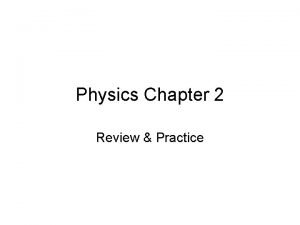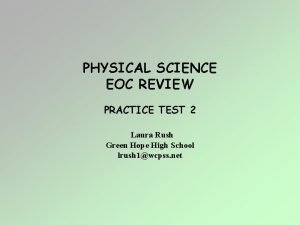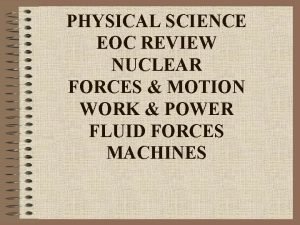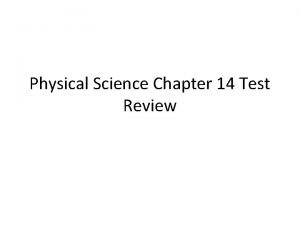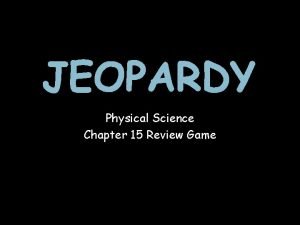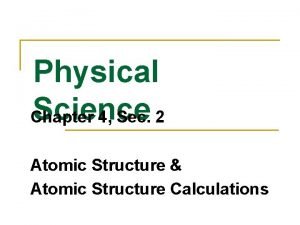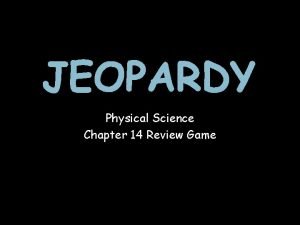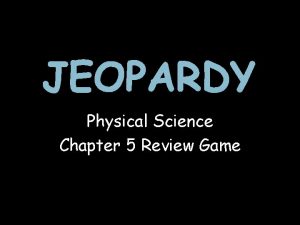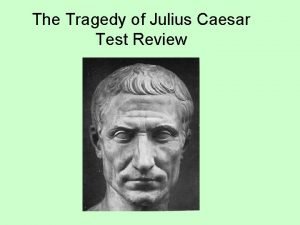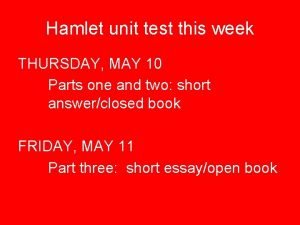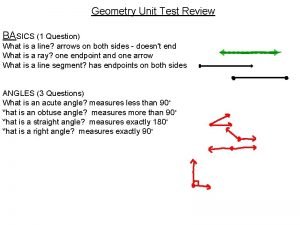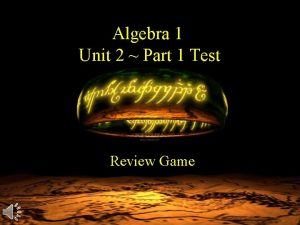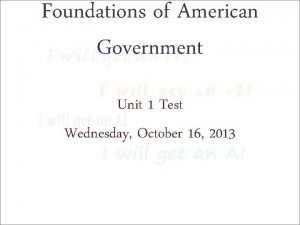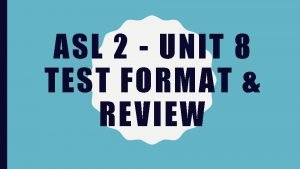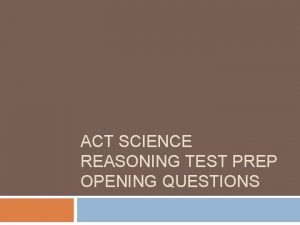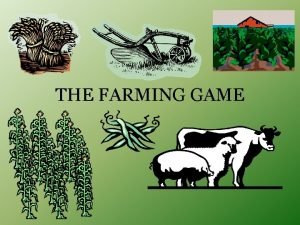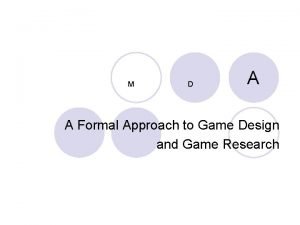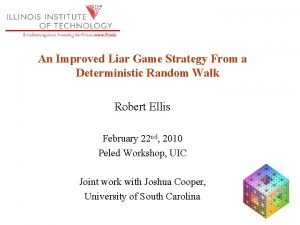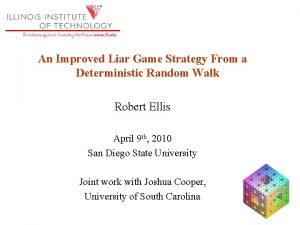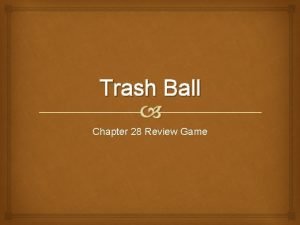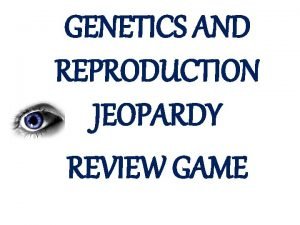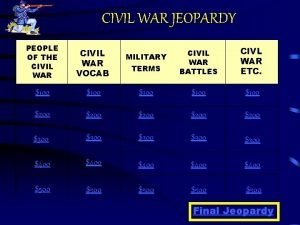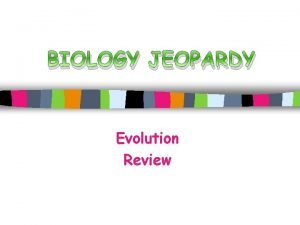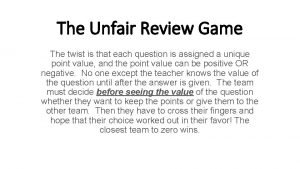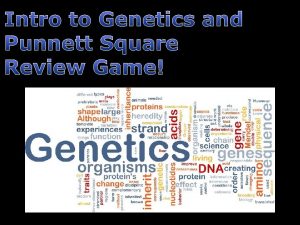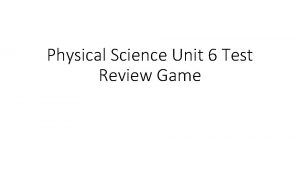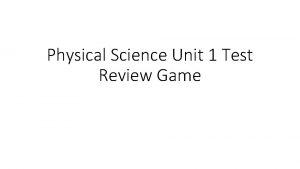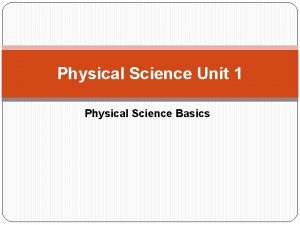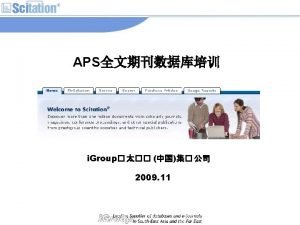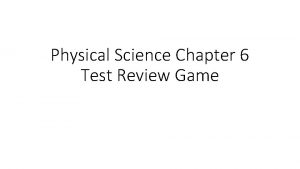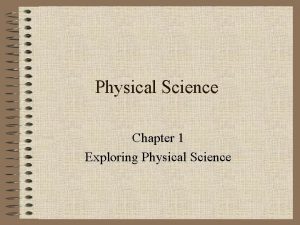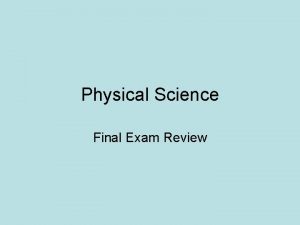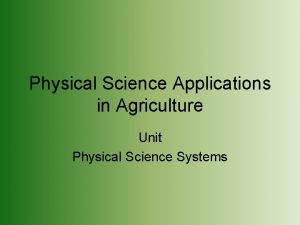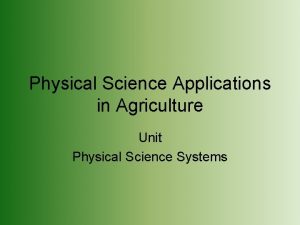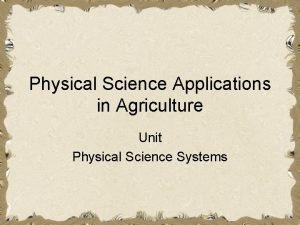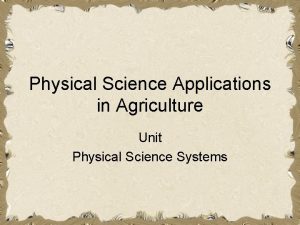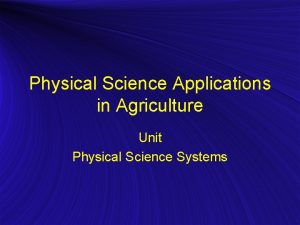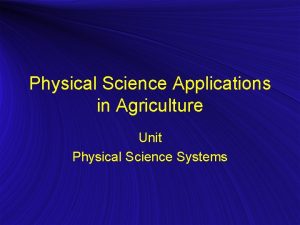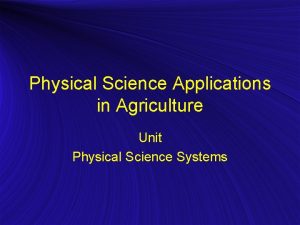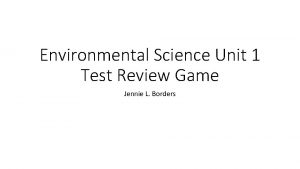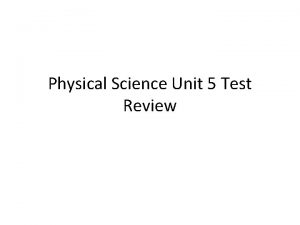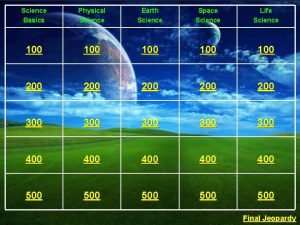Physical Science Unit 4 Test Review Game Unit














































- Slides: 46

Physical Science Unit 4 Test Review Game

Unit 4 Test Review Game 1. Which of the following are pure substances? • a. solutions • b. compounds • c. homogeneous mixtures • d. colloids b

Unit 4 Test Review Game 2. If an unknown substance CANNOT be broken down into simpler substances, it is • a. a compound. • b. an element. • c. made of one kind of atom. • d. both b and c d

Unit 4 Test Review Game 3. Which of the following is a heterogeneous mixture? • a. water in a swimming pool • b. sugar water • c. a jar of mixed nuts • d. stainless steel c

Unit 4 Test Review Game 4. A mixture can be classified as a solution, suspension, or colloid based on the • a. number of particles it contains. • b. size of its largest particles. • c. color of its particles. • d. size of its smallest particles. b

Unit 4 Test Review Game 5. Which of the following is malleable? • a. glass • b. pottery • c. ice • d. gold d

Unit 4 Test Review Game 6. Filtration can be used to separate mixtures based on • a. their boiling points. • b. their densities. • c. their melting points. • d. the size of their particles. d

Unit 4 Test Review Game 7. Which of the following is a physical change? • a. sawing a piece of wood in half • b. burning a piece of wood • c. rust forming on an iron fence • d. a copper roof changing color from red to green a

Unit 4 Test Review Game 8. Which of the following is NOT a clue that a chemical change has occurred? • a. change in color • b. production of a gas • c. formation of a precipitate • d. change in shape d

Unit 4 Test Review Game 9. Which of the following is a chemical change? • a. ice melting • b. ice being carved • c. water boiling • d. water breaking down into hydrogen and oxygen d

Unit 4 Test Review Game 10. A gas has • a. a definite volume but no definite shape. • b. a definite shape but no definite volume. • c. no definite shape or definite volume. • d. a definite volume and definite shape. c

Unit 4 Test Review Game 11. Matter that has a definite volume but no definite shape is a • a. liquid. • b. solid. • c. gas. • d. plasma. a

Unit 4 Test Review Game 12. Which of the following are the forces of attraction so weak that particles can move around freely? • a. solid • b. liquid • c. gas • d. all of the above c

Unit 4 Test Review Game 13. Which of the following factors affects the pressure of an enclosed gas? • a. temperature • b. volume • c. number of particles • d. all of the above d

Unit 4 Test Review Game 14. Raising the temperature of a gas will increase its pressure if the volume of the gas • a. and the number of particles are increased. • b. is increased, but the number of particles is constant. • c. and the number of particles are constant. • d. is constant, but the number of particles is reduced. c

Unit 4 Test Review Game 15. The temperature and volume in a closed container of gas remain constant. If the number of particles of gas is increased, the gas pressure will • a. increase. • b. decrease. • c. remain constant. • d. cause a decrease in the average kinetic energy of the particles. a

Unit 4 Test Review Game 16. What type of change occurs when water changes from a solid to a liquid? • a. a phase change • b. a physical change • c. an irreversible change • d. both a and b d

Unit 4 Test Review Game 17. During a phase change, the temperature of a substance • a. increases. • b. decreases. • c. does not change. • d. increases or decreases. c

Unit 4 Test Review Game 18. The phase change that is the reverse of sublimation is • a. condensation. • b. melting. • c. vaporization. • d. deposition d

Unit 4 Test Review Game 19. If a solid piece of naphthalene is heated and remains at 80°C until it is completely melted, you know that 80 o. C is the • a. freezing point of naphthalene. • b. melting point of naphthalene. • c. boiling point of naphthalene. • d. both a and b d

Unit 4 Test Review Game 20. During which phase change does the arrangement of water molecules become more orderly? • a. melting • b. freezing • c. boiling • d. condensing b

Unit 4 Test Review Game 21. The phase change in which a substance changes from a liquid to a gas is • a. deposition. • b. sublimation. • c. condensation. • d. vaporization. d

Unit 4 Test Review Game 22. The phase change in which a substance changes from a solid to a gas or vapor without changing to a liquid first is • a. sublimation. • b. deposition. • c. vaporization. • d. melting. a

Unit 4 Test Review Game 23. Classify the six phase changes as endothermic or exothermic. Endothermic Exothermic Boiling Melting Sublimation Freezing Condensation Deposition

Unit 4 Test Review Game 24. A child takes a helium-filled balloon outside into the cold air. She notices that the balloon deflates a bit. What most likely caused this to happen? • a. The air pressure inside was higher than the air pressure outside. • b. The cold air outside allowed some of the helium atoms to escape from the balloon. • c. The speed of the helium atoms decreased outside, causing the pressure in the balloon to decrease. • d. The air molecules outside were moving faster than the helium atoms, putting pressure on the outside c surface of the balloon.

Unit 4 Test Review Game 25. Which question would BEST help a student determine which container holds a liquid? • a. Which sample has particles that are electrically charged? • b. Which sample has particles that are sliding past each other? • c. Which sample has particles that are tightly organized in an orderly array? • d. Which sample has particles that are quickly b moving away from each other?

Unit 4 Test Review Game 26. True or False? Chromium (Cr) has 24 protons, 24 neutrons, and 24 electrons. False

Unit 4 Test Review Game 27. If an atom has 34 protons, 40 neutrons and 34 electrons, what is its mass number? • a. 108 • b. 74 • c. 34 • d. 40 b

Unit 4 Test Review Game 28. If an atom of tin has a mass number of 118 and an atomic number of 50, how many neutrons are in its nucleus? • a. 168 • b. 50 • c. 118 d • d. 68

Unit 4 Test Review Game 29. If an atom of an element has a mass number of 32 and 20 neutrons in its nucleus, what is the atomic number of the element? • a. 12 • b. 32 • c. 52 a • d. 20

Unit 4 Test Review Game 30. In an atomic model that includes a nucleus, positive charge is located where? • A. in the nucleus • B. in various locations in the atom • C. outside of the nucleus • D. in the electron cloud a

Unit 4 Test Review Game 31. What is unique for each element on the periodic table? • A. number of protons • B. number of neutrons • C. number of electrons • D. mass and charge a

Unit 4 Test Review Game 32. True or False. If the nucleus of an atom has 12 protons and 14 neutrons, then the element is Silicon. False

Unit 4 Test Review Game 33. How many neutrons does Palladium-108 (Pd) contain? 62

Unit 4 Test Review Game 34. How many protons does Cerium-140 (Ce) contain? 58

Unit 4 Test Review Game 35. How do isotopes of elements differ? Different numbers of neutrons OR different mass numbers

Unit 4 Test Review Game 36. The Greek philosopher Democritus coined what word for a tiny piece of matter that cannot be divided? • A. element • B. atom • C. electron • D. molecule B

Unit 4 Test Review Game 37. J. J. Thomson’s experiment provided evidence that an atom • A. is the smallest particle of matter. • B. contains negatively charged particles. • C. has a negative charge. • D. has a positive charge B

Unit 4 Test Review Game 38. Rutherford’s gold foil experiment provided enough evidence for which of the following statements? • A. Negative and positive charges are spread evenly throughout an atom. • B. Alpha particles have a positive charge. • C. Gold is not as dense as previously thought. • D. There is a dense, positively charged mass in the center of an atom. D

Unit 4 Test Review Game 39. To find the number of neutrons in an atom, you would subtract • A. mass number from atomic number. • B. atomic number from mass number. • C. atomic number from electron number. • D. isotope number from atomic number. B

Unit 4 Test Review Game 40. Which statement is true about oxygen-17 and oxygen-18? • A. They do not have the same number of protons. • B. Their atoms have an identical mass. • C. They are isotopes of oxygen. • D. They have the same mass number. C

Unit 4 Test Review Game 41. What is the difference between an atom in the ground state and an atom in an excited state? • A. The atom in the ground state has less energy and is less stable than the atom in an excited state. • B. The atom in an excited state has one fewer electron than the atom in the ground state. • C. The atom in an excited state has more energy and is less stable than the atom in the ground state. • D. The atom in an excited state has one more electron than the atom in the ground state. C

Unit 4 Test Review Game 42. Which statement accurately describes the arrangement of electrons in Bohr’s atomic model? • A. Electrons vibrate in fixed locations around the nucleus. • B. Electrons travel around the nucleus in fixed energy levels with energies that vary from level to level. • C. Electrons travel around the nucleus in fixed energy levels with equal amounts of energy. • D. Electrons travel randomly in the relatively large space outside the nucleus. B

Unit 4 Test Review Game 43. Which subatomic particles are primarily responsible for giving an atom its mass? • A. electrons and neutrons • B. protons and neutrons • C. electrons, only • D. protons, only B

Unit 4 Test Review Game 44. A neutral atom of sulfur contains 16 protons, 16 electrons, and 16 neutrons. Which of the following describes the constituents of an atom that is of an isotope of sulfur? • A. 16 protons, 17 electrons, 16 protons • B. 17 protons, 17 electrons, 17 neutrons • C. 17 protons, 16 electrons, 16 neutrons • D. 16 protons, 16 electrons, 17 neutrons D

Unit 4 Test Review Game 45. What were discovered as a result of experiments with a cathode ray? • A. protons only • B. nuclei • C. neutrons • D. electrons and protons D
 Unit test algebra 2
Unit test algebra 2 Unit 10, unit 10 review tests, unit 10 general test
Unit 10, unit 10 review tests, unit 10 general test Physics chapter 2 review answers
Physics chapter 2 review answers Physical science eoc study guide
Physical science eoc study guide Physical science eoc review
Physical science eoc review Section 4 review physical science
Section 4 review physical science Physical science chapter 14 test
Physical science chapter 14 test Chapter 15 review physical science
Chapter 15 review physical science Physical science chapter 4 review
Physical science chapter 4 review Chapter 14 review physical science
Chapter 14 review physical science Physical science jeopardy
Physical science jeopardy Physical science chapter 5 review
Physical science chapter 5 review Physical science chapter 6 review answers
Physical science chapter 6 review answers Chapter 16 review physical science
Chapter 16 review physical science Mind map of branches of science
Mind map of branches of science Natural science vs physical science
Natural science vs physical science What is my favourite subject?
What is my favourite subject? Locard's exchange principle
Locard's exchange principle Khubris
Khubris Hamlet unit test review
Hamlet unit test review Unit test review geometry
Unit test review geometry Function algebra unit test part 1
Function algebra unit test part 1 Why did mrs. putnam send her daughter to tituba
Why did mrs. putnam send her daughter to tituba Unit 1 test review us history
Unit 1 test review us history Foundations of american government unit 1 test review
Foundations of american government unit 1 test review The main reason for the dpn protest was to ________.
The main reason for the dpn protest was to ________. Romeo and juliet unit test review
Romeo and juliet unit test review Unit 6 test review algebra 1
Unit 6 test review algebra 1 Science reasoning test
Science reasoning test A student examines the winged insect shown below.
A student examines the winged insect shown below. Abcdefg game
Abcdefg game Farming game rules pdf
Farming game rules pdf A formal approach to game design and game research
A formal approach to game design and game research Game lab game theory
Game lab game theory Liar game game theory
Liar game game theory Liar game game theory
Liar game game theory Trash ball game
Trash ball game Romeo and juliet timeline review answers
Romeo and juliet timeline review answers Genetics jeopardy review game
Genetics jeopardy review game What is gettysburg
What is gettysburg Evolution jeopardy review game
Evolution jeopardy review game Pulls the hair follicle into an upright position
Pulls the hair follicle into an upright position World war 2 jeopardy questions
World war 2 jeopardy questions Genetics review game
Genetics review game Transformations review game
Transformations review game Codomain
Codomain Literary terms review game
Literary terms review game


